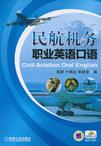民航机务职业英语口语
出版时间:2010-9 出版社:机械工业出版社 作者:屈静,等 编 页数:126
Tag标签:无
内容概要
《民航机务职业英语口语》内容涉及航线例行工作对话、机上与机组人员对话以及航线排故对话三大常用模块,共分15个单元,旨在帮助学生掌握语言的交际功能,结合飞机维修工作的工作程序,有针对性地培养学生专业英语基础口头表达能力。《民航机务职业英语口语》在编写过程中,始终以飞机维修的工作情景为主线,以语言交际功能为中心,改变了以往教材中每篇材料均配有生词及词组的编写模式,多层次地为学生提供了口语表达素材,为因材施教创造条件。《民航机务职业英语口语》既可以作为民航高校以及职业院校机务专业学生的英语口语教材,同时也可作为航空公司的机务工程部以及飞机维修公司的在职人员的英语口语培训教材。
书籍目录
前言Unit One Routine Working Procedures on the LinePart A Towing the PlanePart B Communicative FunctionsGreetingsIntroductionsPart C Pronunciation and IntonationThe Vowel IPart D Aviation LanguageThe General Idea for Towing and TaxiingThe Landing GearUnit Two Pushback ProceduresPart A Pushing the PlanePart B Communicative FunctionsStarting a ConversationPart C Pronunciation and IntonationThe Vowel ⅡPart D Aviation LanguageATA 32 Landing Gear SystemsUnit Three Dialogues during Working ProcedurePart A Daily CommunicationsPart B Communicative FunctionsAsking for Help and Offering HelpOffering and Accepting HelpPart C Pronunciation and IntonationThe Consonant IPart D Aviation LanguageGeneral Introduction to EngineGeneral Description of Engine CFM 56-7Unit Four Dialogues on the Door ProblemsPart A Door ProblemsPart B Communicative FunctionsAsking for Information and Giving InformationInquiring about the Repair Capability on the PhonePart C Pronunciation and IntonationThe Consonant ⅡPart D Aviation LanguageCargo DoorATA 52 DoorsUnit Five Dialogues on Engine Problems (1)Part A Engine ProblemsPart B Communicative FunctionsDescribing Things and PhenomenaPart C Pronunciation and IntonationThe Semi-vowelsPart D Aviation LanguageA Brief Introduction to Electrical PowerUnit Six Dialogues on Refueling ProblemsPart A Refueling ProblemsPart B Communicative FunctionsGiving AdvicePart C Pronunciation and IntonationThe PronunciationPart D Aviation LanguageThe Fuel SystemUnit Seven Dialogues on Dispatching the PlanePart A Dispatch the Plane with Some ProblemsPart B Communicative FunctionsSeeking and Giving OpinionsPart C Pronunciation and IntonationThe Intonation IPart D Aviation LanguageFuselage of the Boeing 737Unit Eight Dialogues on SOCPart A Visiting SOC JobsitePart B Communicative FunctionsPossibility and ImpossibilityExpressing Certainty and UncertaintyPart C Pronunciation and IntonationThe Intonation ⅡPart D Aviation LanguageA Brief Introduction to SOCUnit Nine Dialogues on Engine OilPart A Rep]enish the Engine OilPart B Communicative FunctionsExpressing AgreementExpressing DisagreementPart C Pronunciation and IntonationThe Intonation ⅢPart D Aviation LanguageEngine Oil SystemPhysical Description to Oil TankUnit Ten Dialogues on Engine Problems (2)Part A Leakage Problem and Testing the EnginePart B Communicative FunctionsSeeking and Making ClarificationPart C Pronunciation and IntonationThe Rhythm IPart D Aviation LanguageAir Conditioning SystemUnit Eleven Dialogues on Daily Problems with the AircraftPart A Parking Brake Valve DeactivationPart B Communicative FunctionsComplainingApologizingPart C Pronunciation and IntonationThe Rhythm ⅡPart D Aviation LanguageImplementing RNP ARUnit Twelve Dialogues on Common Maintenances with the AircraftPart A Reservoir Depressurization and Fuel Sump DrainagePart B Communicative FunctionsPermission SeekingPart C Pronunciation and IntonationThe Stress IPart D Aviation LanguageBasic Hydraulic SystemATA 29 Hydraulic SystemUnit Thirteen Office Communication on the PhonePart A Urging the Component Repair Company to do the Repair on the Phon~Part B Communicative FunctionsAsking for Delivery InformationAsking for and Giving Meeting InformationPart C Pronunciation and IntonationThe Stress ⅡPart D Aviation LanguageUnit Fourteen Communication with the GE Representative on the PhonePart A Remove the Oil Filter for AnalysisPart B Communicative FunctionsMaking and Receiving NotificationPart C Pronunciation and IntonationComprehensive Practice IPart D Aviation LanguageATA Flight Controls SystemUnit Fifteen Communication with the Airbus Representative on the PhonePart A Asking for Help from Airbus OfficePart B Communicative FunctionsReminding and RememberingPart C Pronunciation and IntonationComprehensive Practice ⅡPart D Aviation LanguageTCAS System附录 国际航空无线电26英文字母读法表参考文献
章节摘录
Landing gear non-retraction during take-off phase is a key factor in in-flight interruptions. Itrepresents roughly 14% of fleet reports. Although significant decrease in rate has been demonstratedon ATA 32, the large number of equipments involved in the landing gear extension/retractionsequence still gives a remote, but wide, spread of failure modes. The proposals given provide simple and proven advice to significantly reduce ATA 32 relatedflight interruptions. The first one, related to ground lock pins and ground lock sleeves, commonly called "safetydevices", or "safety pins", may appear obvious. However, the increase of flight interruptionsreported due to safety devices forgotten on the landing gear prior to take off, combined with anincrease of queries on the subject led us to make known Airbus operator experiences. The other one relates to the nose landing gear (NLG) "flight/ground" indication system. Thisitem aims to address improvements and thus to correct one of the main contributing factors tolanding gear retraction failure.GROUND LOCK SAFETY DEVICES Installation of the landing gear safety devices (ground lock pins and collars), when the aircraftis towed or pushed-back during flight operation is optional. Airbus doesn't intend to makerecommendations to favour one way or the other as some airlines require installation of ground lockpins and collars, whereas some do not want to do this. ……
图书封面
图书标签Tags
无
评论、评分、阅读与下载
